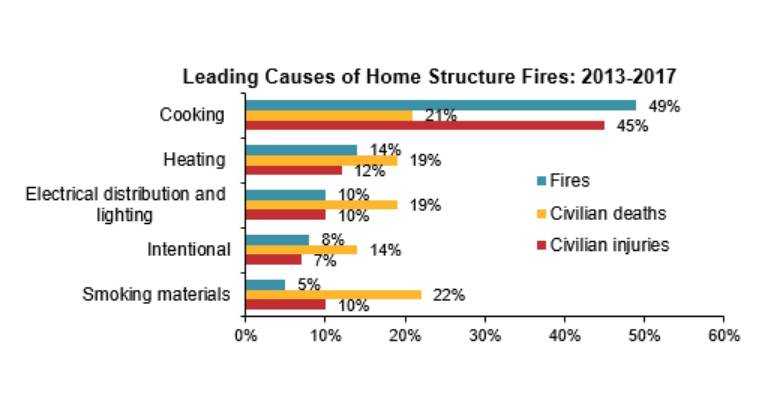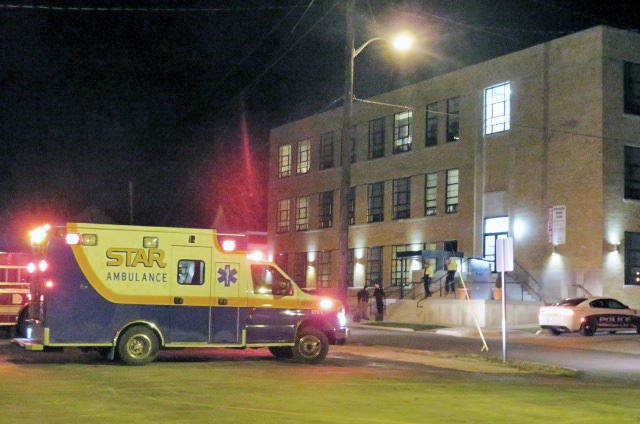Cooking fires are leading type of fires in nation

Unattended cooking is the leading cause of house fires across the nation.
Brazil Fire Chief Jake Bennett confirmed city firefighters responded to 27 similar reports involving cooking fires or smoke scares because of cooking fires in 2019, and the first report of a cooking fire in 2020 took place this week.
“Cooking-type fires seem to be a common response for our department,” said the fire chief, adding they appear to be more prevalent in multi-occupancy buildings, but they also happen in single-family dwellings. “Lack of attentiveness is a big part of the cause. When accidents like these happen, we’re most concerned with the injury and safety of the occupants.”

Around 8:30 p.m. Tuesday, Clay County 911 Dispatch was notified of Heavy smoke in the Davis Zellar Place apartment complex at 202 North Washington Street.
Members of the Brazil fire and police departments responded quickly with STAR Ambulance to the scene.
There was a haze in the hallways of the building, and firefighters were able to smell burned food upon arrival. However, firefighters later discovered a cooking fire in a first-floor apartment. No significant damage or injuries were reported during the incident.
The National Fire Prevention Association (NFPA) is a leading source of resource information about the causes and circumstances of various types of home and structure fires reported to fire departments in the United States.
According to the NFPA, every 24 seconds, a fire department in the United States responds to a fire somewhere in the nation, with 49 percent reported to be caused by unattended cooking.
Estimates of 173,200 home structure fires per year started by cooking activities in 2013-2017, averaging out to some 470 home cooking fires per day. These fires have caused an average of 550 civilian deaths, 5,020 reported civilian fire injuries, and $1.2 billion in direct property damage per year.
Some other interesting data from the NFPA study (2013-2017) includes:
• Ranges or cooktops were involved in 62 percent of reported home cooking fires, 89 percent of cooking fire deaths, and 79 percent of cooking fire injuries.
• Households that use electric ranges have a higher risk of cooking fires and associated losses than those using gas ranges.
• Unattended cooking was the leading cause of cooking fires and casualties.
• Clothing was the item first ignited in less than 1 percent of these fires, but clothing ignitions led to 14 percent of the home cooking fire deaths.
• Almost one-third (30 percent) of the people killed by cooking fires were sleeping at the time. More than half (53 percent) of the non-fatal injuries occurred when people tried to control the fire themselves.
Unattended cooking is a national problem for fire departments everywhere, and Bennett wants to discuss safety.
“We urge individuals to remain calm when they face a cooking fire and make a conscious decision on whether the fire is something they can address by smothering with a lid, or in some cases, an extinguisher,” said Bennett. “If the fire is larger than what you can handle, or the smoke is overwhelming, get yourself and all occupants out and call 911. We will handle it.
The biggest safety tip and preventative measure for everyone to remember are to remain in the kitchen while cooking and keep a watchful eye to what is happening. Of equal importance, cooks need to make sure to keep anything flammable that could catch fire — like oven mitts, wooden utensils, recipe books/magazines, food packaging, towels or curtains — away from the cooking surface.
“If you can safely turn the burner or oven or appliance off, we encourage that,” said Bennett. “We just want people to be as attentive as possible to avoid cooking accidents and if they do find themselves in those types of emergencies to be as safe as possible when addressing them.”
The United States Fire Administration and FEMA mottos are “fire is everyone’s fight,” and they provide the following safety tips:
• Stand by your pan: Don’t leave the kitchen without turning the burner off.
• Watch what you are cooking: Monitor the heat while cooking and if it gets too high, smoke appears or grease begins to boil, turn off the burner and remove the pan from the heat source.
• Turn pot handles toward the back of the stove to ensure pans won’t be bumped into or be pulled over.
• Keep a pan lid or baking sheet nearby in case a pan catches on fire. This will put out the fire by smothering it.
• Never throw water on a grease fire.
If an oven fire happens, turn off the heat and keep the door closed.
Firefighters agree that every home should have at least one fire extinguisher in the kitchen area. A dry chemical fire extinguisher will work on all kinds of fires; including trash, wood, and paper; flammable liquids; and electrical blazes
Keep at least one fire extinguisher on every floor of your home, including the basement and attic, if you have them. In the kitchen or near sources of heat may seem like common-sense places to keep a fire extinguisher, but fires can start anywhere at any time in your home.
While grease fires can be the greatest risk of fires in the kitchen, there is also an unusual tip to remember when cooking: Don’t cook if you are tired, sleepy, or you been drinking.
Microwaves can also catch fire due to improper cleaning, severely overheated food or packaging materials, arcing of metal pieces or foil bags during the cooking process, and heating of improper non-food products such as cotton clothing. If a fire occurs, turn the unit off and unplug the power cord. Do not open the door of the microwave; simply wait till the fire suffocates. Never open the door until you are absolutely sure the fire is out. If you are in fear the fire might spread, call the fire department immediately.
“A big preventive measure to keeping you and your family safe is having working smoke detectors in your home,” said Bennett, adding there is no excuse for not having them. “Through our partnership with the American Red Cross, we offer a free smoke detector program with free installation too. Contact (812) 446-7551 and Brazil firefighters will provide 10-year lithium battery smoke detectors for residents, and schedule the installation.”
